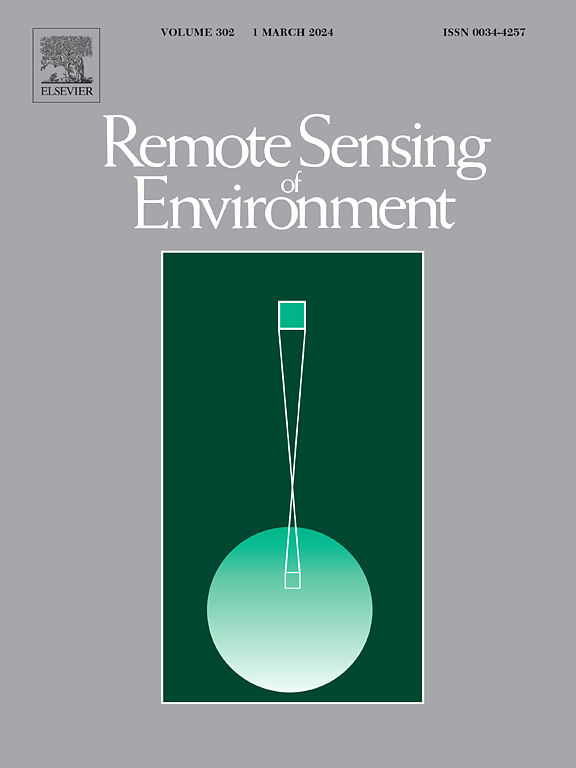了解Sentinel-1和Sentinel-2模式和基准数据集的洪水检测模型
IF 11.1
1区 地球科学
Q1 ENVIRONMENTAL SCIENCES
引用次数: 0
摘要
近年来,基于遥感卫星图像的洪水制图研究主要集中在深度学习方法上。虽然新的洪水分割模型被越来越多地提出,但这些工作大多集中在单个数据集上训练的先进架构上。因此,这些研究忽略了现有训练和评估数据的内在局限性和偏差。当这些模型用于现实场景时,这通常会导致较差的泛化和过度自信的预测。为了解决这一差距,这项工作的目标是双重的。首先,我们在五个公开可用的数据集上训练和评估洪水分割模型,这些数据集包括来自Sentinel-1、Sentinel-2以及SAR和多光谱模式的数据。我们的研究结果表明,在单个数据集(数据集内验证)上实现高检测精度的模型不一定能很好地推广到未见过的数据集。相比之下,在来自多个数据集的更多不同样本上训练的模型表现出更强的鲁棒性和泛化能力。此外,我们提出了一个双流多模态架构,可以在单模态和双模态数据集上独立训练和测试。这使得所有可用数据的多样性和丰富性能够整合到一个单一的统一框架中。结果强调需要使用多样化和精心设计的数据集进行更全面的验证,特别是对于多模式方法。如果不能充分解决当前数据集的缺点,将极大地限制基于深度学习的洪水制图方法的潜力。本文章由计算机程序翻译,如有差异,请以英文原文为准。
Understanding flood detection models across Sentinel-1 and Sentinel-2 modalities and benchmark datasets
In recent years, research in flood mapping from remote sensing satellite imagery has predominantly focused on deep learning methods. While new flood segmentation models are increasingly being proposed, most of these works focus on advancing architectures trained on single datasets. Therefore, these studies overlook the intrinsic limitations and biases of the available training and evaluation data. This often leads to poor generalization and overconfident predictions when these models are used in real-world scenarios. To address this gap, the objective of this work is twofold. First, we train and evaluate flood segmentation models on five publicly available datasets including data from Sentinel-1, Sentinel-2, and both SAR and multispectral modalities. Our findings reveal that models achieving high detection accuracy on a single dataset (intra-dataset validation) do not necessarily generalize well to unseen datasets. In contrast, models trained on more diverse samples from multiple datasets demonstrate greater robustness and generalization ability. Furthermore, we present a dual-stream multimodal architecture that can be independently trained and tested on both single-modality and dual-modality datasets. This enables the integration of all the diversity and richness of the available data into a single unified framework. The results emphasize the need for a more comprehensive validation using diverse and well-designed datasets, particularly for multimodal approaches. If not adequately addressed, the shortcomings of current datasets can significantly limit the potential of deep learning-based operational flood mapping approaches.
求助全文
通过发布文献求助,成功后即可免费获取论文全文。
去求助
来源期刊

Remote Sensing of Environment
环境科学-成像科学与照相技术
CiteScore
25.10
自引率
8.90%
发文量
455
审稿时长
53 days
期刊介绍:
Remote Sensing of Environment (RSE) serves the Earth observation community by disseminating results on the theory, science, applications, and technology that contribute to advancing the field of remote sensing. With a thoroughly interdisciplinary approach, RSE encompasses terrestrial, oceanic, and atmospheric sensing.
The journal emphasizes biophysical and quantitative approaches to remote sensing at local to global scales, covering a diverse range of applications and techniques.
RSE serves as a vital platform for the exchange of knowledge and advancements in the dynamic field of remote sensing.
 求助内容:
求助内容: 应助结果提醒方式:
应助结果提醒方式:


